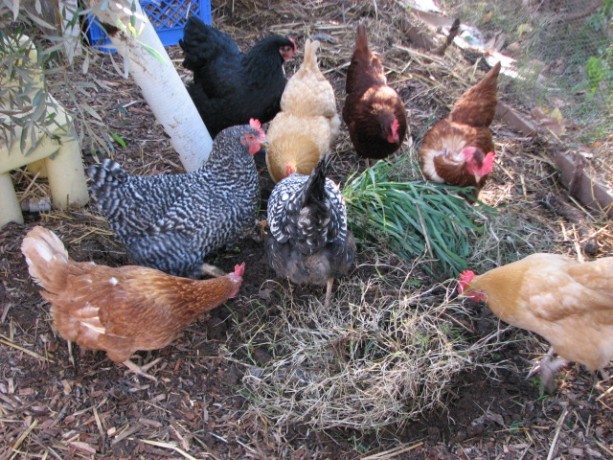- Animals, Building and Landscaping, Chickens, Compost, Gardening adventures, Irrigation and Watering, Other Insects, Permaculture and Edible Forest Gardening Adventures, Planting, Predators, Recycling and Repurposing, Seeds, Soil, Water Saving
A Garden Coop
 If you want chickens and vegetables, and have predators and opportunists trying to eat what you grow, and perhaps have limited space, this design may be for you. I did not come up with it; I don’t know who did and I give lots of credit to that person because this makes so much sense. I’ll be converting our Fowl Fortress into one as I can.
If you want chickens and vegetables, and have predators and opportunists trying to eat what you grow, and perhaps have limited space, this design may be for you. I did not come up with it; I don’t know who did and I give lots of credit to that person because this makes so much sense. I’ll be converting our Fowl Fortress into one as I can.It is the Garden Coop. You build one structure of strong wire with small gauge holes to keep rats, mice and snakes out, keep your hens on one side and garden in the other, then switch.
Start with cemented posts. Your coop can be of any dimension depending upon how many chickens and how much gardening space you will need. Take that number and multiply it by two. Instead of wood you can use metal posts with metal spacers across the top if that is more cost effective for you. Make it 7 or 8 feet tall, for comfort to walk in and also to give you more vertical growing space.
Wrap the entire structure with wire, all sides and across the top, and at least six inches into the ground all the way around. This helps prevent digging animals from getting into the coop. As we have coyotes, I also pounded 6″ pieces of rebar into the perimeter every 6 inches. If you have gopher problems, then bury wire 2.5′ into the ground around the perimeter. Hardware cloth would be best although the small chicken wire is more flexible to work with. When you overlap the wire cloth be sure to sew it closed or wrap and tuck the edges, otherwise rats and mice will slip through.
Put your hen house in the center of the coop; the house should have doors on two sides.
Divide your coop in half with wire down the middle. The wire should go around the hen house, and the hen house doors should open into each half of the garden.
Now you can keep your hens in one half and garden in the other half. When a season ends, switch them.
You’ll have all of your fruit and vegetables safe from squirrels, rats, mice and birds. You’ll have vertical space on which to grow your vines. When you switch, you’ll be gardening in insect-free, well manured soil and your hens will have excellent food sources. They will be working without being let loose, and will have an active and healthy life without becoming prey. They will take apart your old garden and fix it for the next switch.
All of your water needs are in one place. All of your composting is in one place. All of your vegetable and egg gathering is in one place. You get to harvest all of your vegetables and eggs without feeding rodents. What you don’t want, you toss to the hens. All with one structure, one initial cost. Its a chicken tractor that doesn’t move!
Because you are keeping animals out physically and controlling insects with hens, you won’t be enticed to use traps, bait, sprays, etc.
You can also grow around the outside perimeter of the coop. Just be aware of shade issues from vines (maybe a good thing?) grown over the top. Summer shade with a deciduous vine may be just right for keeping your hens and garden cooler.
Its a great idea, and maybe the one that will help you succeed in your garden.
- Animals, Bees, Birding, Building and Landscaping, Chickens, Cob, Compost, Composting toilet, Fungus and Mushrooms, Gardening adventures, Giving, Health, Heirloom Plants, Hiking, Houses, Hugelkultur, Humor, Living structures, Natives, Natural cleaners, Other Insects, Permaculture and Edible Forest Gardening Adventures, Pets, Photos, Predators, Quail, Rain Catching, Recycling and Repurposing, Reptiles and Amphibians, Seeds, Soil, Vegetables, Water Saving, Worms
Special Tours for Aug. and Sept., 2014
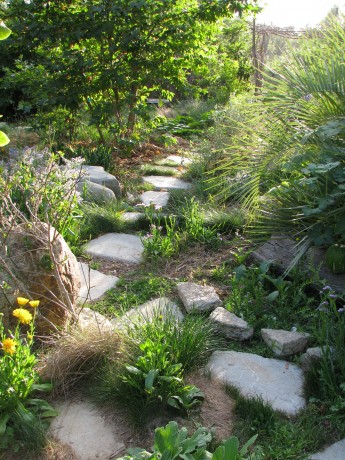
Come take a tour of a food forest! Normally tours of Finch Frolic Garden are held by appointment for groups of 5 – 15 people, Thursdays – Mondays. Cost is $10 per person and the tour lasts about two hours. By popular demand, for those who don’t have a group of five or more, we will be hosting Open Tour days for the first 15 people to sign up in August and September. They will be Sunday, August 10 and 24, Sept. 7 and 21, and Thursdays August 7 and 28, and Sept. 11 and 25. Tours begin promptly at 10 am. The tours last about two hours and are classes on basic permaculture while we tour the food forest. I ask $10 per person. Please reserve and receive directions through dianeckennedy@prodigy.net. Children under 10 are free; please, no pets. Photos but no video are allowed. Thank you for coming to visit! Diane and Miranda
- Animals, Bees, Birding, Books, Building and Landscaping, Chickens, Cob, Compost, Composting toilet, Fungus and Mushrooms, Gardening adventures, Heirloom Plants, Hugelkultur, Humor, Living structures, Natives, Natural cleaners, Other Insects, Permaculture and Edible Forest Gardening Adventures, Ponds, Predators, Quail, Rain Catching, Recycling and Repurposing, Reptiles and Amphibians, Seeds, Soil, Water Saving, Worms
Permaculture Lectures At Finch Frolic Garden, June 2014
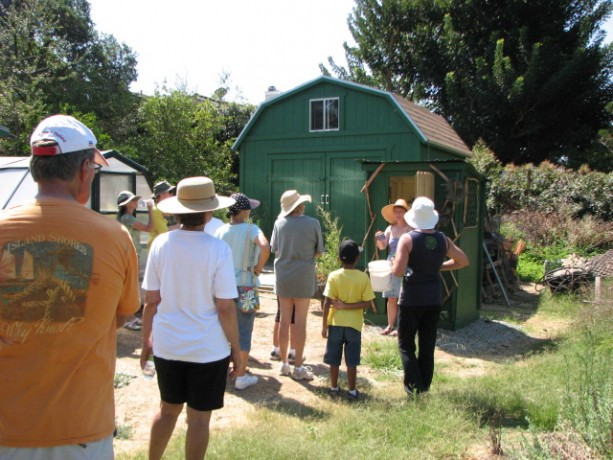
Tour Finch Frolic Garden! Permaculture Lectures in the Garden!
Learn how to work with nature and save money too
Finch Frolic Garden and Hatch Aquatics will present four fantastic, information-filled lectures in June. Join us at beautiful Finch Frolic Garden in Fallbrook, 4 pm to 6 pm, for refreshments and talks on…
Saturday, June 7: Introduction to Permaculture and Finch Frolic Tour: We’ll take you through the main precepts of permaculture and how it can be applied not only to your garden, but to yourself and your community. Then we’ll tour Finch Frolic Garden and show rain catchments, swales, plant guilds, polyculture, living buildings and so much more.
Saturday, June 14: Your Workers in the Soil and Earthworks: Learn the best methods for storing water in the soil and how to replace all your chemicals with actively aerated compost tea and compost.
Saturday, June 21: Aquaculture: You can have a natural pond – even in a tub! How natural ponds work, which plants clean water and which are good to eat. Even if you don’t want a pond, you’ll learn exciting information about bioremediation and riparian habitat.
Saturday, June 28: Wildlife in your Garden: What are all those bugs and critters and what they are doing in your yard? We’ll discuss how to live with wildlife and the best ways to attract beneficial species.
Your hosts and lecturers will be
Jacob Hatch Owner of Hatch Aquatics. With years of installing and maintaining natural ponds and waterways, and a Permaculture Design Course graduate, Jacob has installed earthworks with some of the biggest names in permaculture.
Miranda Kennedy OSU graduate of Wildlife Conservation and wildlife consultant, Miranda photographs and identifies flora and fauna and maps their roles in backyard ecosystems.
Diane Kennedy Owner of Finch Frolic Garden, lecturer, consultant, Permaculture Design Course graduate, former SDC Senior Park Ranger, Diane educates homeowners on how to save money and the environment while building their dream gardens.
Each class limit is 50 attendees, so please make pre-paid reservations soon before they fill up. Fee for set of four lectures and tour is $45 per person. Single session fee is $20 per person. Contact Diane Kennedy at dianeckennedy@prodigy.net for reservations and directions.
You will not want to miss this fascinating and useful information!
- Animals, Bees, Birding, Chickens, Cob, Compost, Composting toilet, Fungus and Mushrooms, Gardening adventures, Health, Heirloom Plants, Hiking, Humor, Living structures, Natives, Natural cleaners, Other Insects, Permaculture and Edible Forest Gardening Adventures, Pets, Photos, Ponds, Predators, Quail, Rain Catching, Reptiles and Amphibians, Seeds, Soil, Water Saving, Worms
Finch Frolic Facebook!
Thanks to my daughter Miranda, our permaculture food forest habitat Finch Frolic Garden has a Facebook page. Miranda steadily feeds information onto the site, mostly about the creatures she’s discovering that have recently been attracted to our property. Lizards, chickens, web spinners and much more. If you are a Facebook aficionado, consider giving us a visit and ‘liking’ our page. Thanks!
- Animals, Arts and Crafts, Chickens, Compost, Gardening adventures, Other Insects, Permaculture and Edible Forest Gardening Adventures
A Hen’s Garden
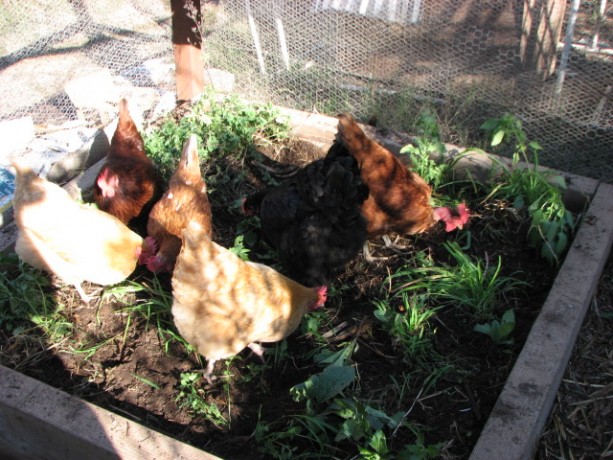
The girls helping prepare the soil before planting. Chickens are primarily bug eaters who also snack on greens. Feeding hens grains began with the industrialization of agriculture. No one cutting grain with a hand scythe would spend all that time and energy to feed hens.
My hens live in the Fowl Fortress, to protect them from coyotes and hawks (our hawks won’t be able to carry one away but they could tear them up pretty badly). After losing Chickpea to a coyote while we were only so many yards away made me eliminate any open foraging time for the girls. This wasn’t healthy for them. I haven’t invested in a solar electric fence yet, to make a ‘day’ coop for them to forage in relative safety, but that may be on my investment list for the new year. The largest problem is poor design in the garden, which I’m trying to remedy as easily and inexpensively as possible. I didn’t know how to fit in chickens, or where the garden was going when it began nearly three years ago. I have weedy areas, and I have chickens. To bring them together safely is the problem.
Sometimes we bring the hens into the fenced yard with our 100-pound African spur thigh tortoise (Gammera); however, that yard is also where some of our cats live. We’re not sure if Moose, Chester and Cody would behave themselves around hens, so unless we prevent the cats from leaving the house for the day, then we can’t carry the hens into this grassy yard to graze.
Inside the Fowl Fortress there is a layer of muck composed of old straw, the hard bits of veggies and fruit fed to the hens, old scratch and lots of chicken poo, made into an anaerobic muck by recent rains. Once turned up we discovered lots of the grain had sprouted, which the girls sucked up like noodles. This muck was also turning the hard ground below into prime soil. Why couldn’t we use this muck in a more productive manner?
If I couldn’t bring the hens to the garden, then I thought I’d bring the garden to them. Inside the Fowl Fortress I propped up four big boards in a square, then filled it with some of the rotting straw and muck from the coop. I topped it with Bermuda grass – laden soil from one of my raised beds. This was the bed, in fact, where I composted in place for the past year. What rich, chocolate-colored, worm-laden soil! If not for the invasive grass it would be perfect.
In this new garden, along with the Bermuda grass, my daughter and I planted oregano we divided from one of our plants, nettles, borage, some other kind of grass weeds that had sprung up after our Fall rain, plus we scattered corn and mixed organic grains which we feed the hens and pressed the seed into the ground.
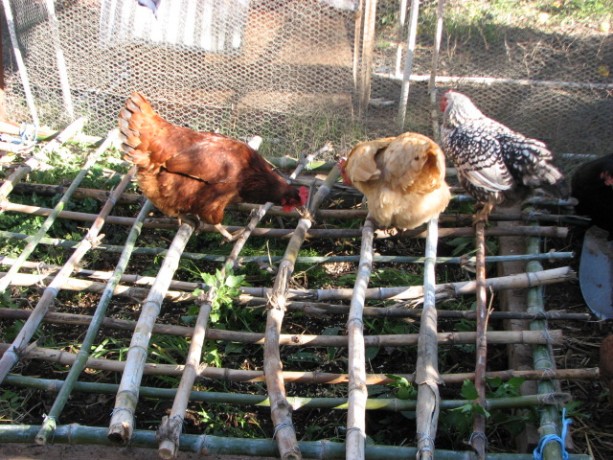
The hens can graze, but can’t uproot the plants. Miranda wired together a bamboo lid out of scrap pieces. The idea is that the plants can grow up through the lattice of the bamboo lid and the hens can stand on it and eat greens. Oregano is a good medicinal herb, as are nettles, which reputedly encourage egg laying.
I also dig up chunks of weeds or Bermuda grass in this mercifully looser post-rain soil, and throw the whole mess into the Fowl Fortress and let the girls forage and exercise those strong legs by kicking through the heap. It is only logical that the strong kicking motion of foraging hens strengthens their bodies so that they have fewer egg-laying illnesses (egg-binding primarily), and of course their nutrition is much better with greens and bugs
This is by no means a permanent solution, but until I find the right design that keeps healthy, safe hens and eliminates weeds without a lot of work, then a chicken garden and weed-tossing is the way to go.
-
Good-bye, Sweet Belle: The Death of a Crossbill Hen

Belle in her bath. Last Tuesday when I opened the chicken tractor to let the girls come bounding and clumsily flutter out for their breakfast, Belle our genetic crossbill Americauna didn’t emerge with her usual energy. I make a custard of blended chicken food, whole eggs, greens and fruit, cooked and cooled, to feed her. The custard contained all the goodies the other hens had, but was easier for her to scoop with her twisted beak. I’d fill her dish before I come down to ‘do the hens’, and she was fed first. Her dish was placed into the top of the quail hut with the door propped open so only Belle coud get in and out; the other hens loved to share her food otherwise.
Although Belle ate vigorously, she never gained full body weight. Her beak prevented her from eating well enough. Out of every five scoop attempts at the custard I’d say that she’d get one mouthful. Yet she was always perky, always running around interested in everything, and even tried dominance tactics over some of the other girls. They’d let her since she wasn’t a threat to any of their food.
Because Belle’s eating habits were very messy her neck and head feathers were straggly, and combined with her twisted beak gave her a comical, slightly crazed look. Because she was handled so much when she patiently allowed us to trim her beak and nails, and give her a bath, she was very friendly. She’d jump on our backs and shoulders any time we’d bend over in the coop. She’d enjoy being carried around. She was very spoiled. We’d read posts where owners of crossbills, who didn’t cull them but kept them as pets, had them live up to ten years and lay eggs. It was all dependant upon to what degree their bills crossed, and Belle’s became severe.
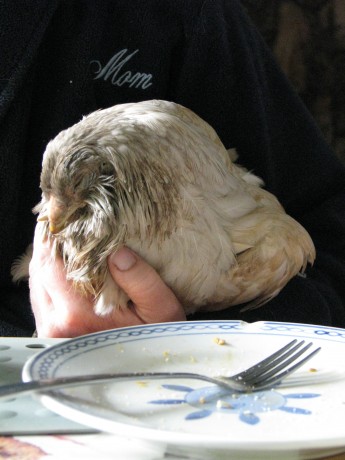
About a month ago we noticed mites on her, something that is common on hens, and gave her a good bath and treatment with food grade diotomaceous earth. The FGDE works immediately and is very effective and safe. Otherwise she was bright, fun and perky, burrowing under the other girls on the roost overnight to cuddle.
Tuesday Belle was slower to come around, and didn’t want to eat. A hungry hen not wanting to eat? Bad news. We immediately took her into the house. It was a cold day, so we made her comfortable next to a space heater. On inspection we discovered that she had mites all over her. We also checked the other hens right away and they were all okay, so apparently Belle’s diminishing health encouraged them to reproduce, and as she couldn’t groom herself she was stuck. We coated her with FGDE, not wanting to bathe her while she was feeling poorly since it was a cold day, and dropper fed her food. She showed some energy and wanted to run around, and took the food hungrily.
It was time to trim the Christmas tree, and my daughter put Belle under her sweater to keep her warm and comforted as we worked; Belle loved being cuddled and held, so she put up no resistance, but we could see that she was ill.
We brought in the cage that we used for Viola the ex-house chicken, and for all of our patients, and tucked Belle in for the night next to the space heater.
In the morning Belle was sitting very still. I knew that she was nearly gone. Just after waking my daughter, Belle died as she held her. She is buried outside our bay window where we watch birds, close to the house.
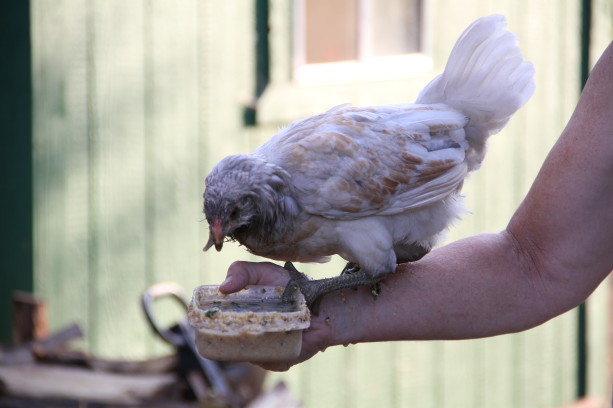
Belle usually can’t wait until she’s served. Birds are so tricky. They can seem perfectly fine, but when they show illness it is usually too late and the end comes quickly. There is little you can do for them besides keep them comfortable. Neither of us expected Belle to pass away; she showed no previous symptoms and was her usual plucky, fun self. Something internal gave way from slow malnutrition caused by that darned crossed bill and her inability to eat enough. On reflection I don’t think that Belle had a bad life. She ate enough to not be hungry all the time, and her custard gave her ease of eating. She was much loved and spoiled. Her end was quick, which was merciful and not granted to many of us. But Belle will always be remembered.

Ah haz a friend! -
Coyotes
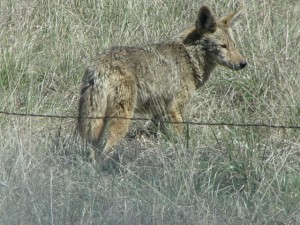
A coyote from some years back. Fall and winter are the times of year when many outdoor pets disappear. I’ve blogged on this before, too. ‘Teenaged’ coyotes, hungry (just like human teens!), bolder and less cautious will come closer to homes and people to grab food. If there is pet food outside the house, coyotes will take it if they can. If you have small pets outside, even chained, they can be killed by coyotes.
This doesn’t make coyotes evil. They are predators, a very necessary part of the food chain. Look up ‘trophic cascade’. That is how preditors in a wild environment cause prey animals to keep moving in natural patterns. Unthreatened, not only can prey animals reproduce to extremes, but also they will linger over feeding areas and eat plants down to the ground rather than trim them and move on.
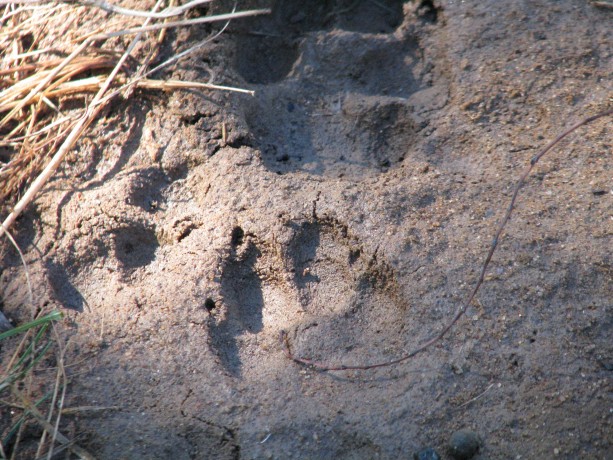
Coyote pawprints by the pond where they stopped for a drink. Dog pawprints have nails; cat (mountain lion!) pawprints don’t because their nails retract. Coyotes are intelligent, loyal, family-oriented, playful animals. They also make very scary sounds when howling and yipping in packs. Coyotes are no threat to humans unless the coyotes are sick, or if a child comes close when a coyote is eating outdoor pet food and is frightened.
Now that our last dog, Sophie, has passed away, coyotes are jumping the five-foot chainlink fence nightly and hunting in our yard. They have been unable to breach the Fowl Fortress (the hens are also locked into their coop within the FF for double protection). Unfortunately on Halloween I let the hens out of the coop about 45 minutes before dark. They had just gone under the Mock Pavilion, and I went into the FF to give Belle some of her special mash when there was a wild clucking. A coyote had come close and grabbed Chickpea our Americauna, and they were gone. My daughter saw it running away, and I dashed after, losing my slippers on the way, and hunted all over the neighbor’s yard but there was no sign of her.
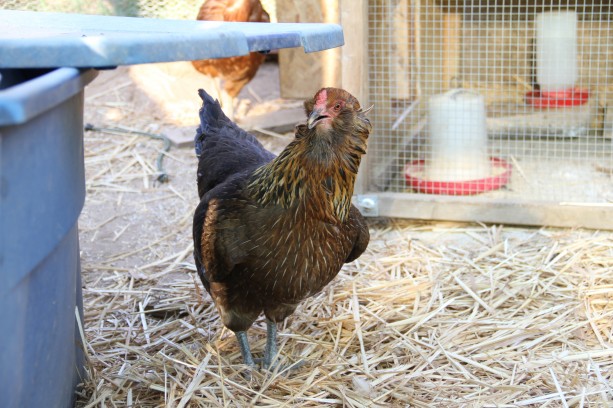
It was tramatizing, and I kick myself because I should have known better, even though I was just yards away and the hens had been released only minutes before. It was a lucky chance for the coyote, who must have already been in the yard but hidden by plants. At least it was a quick death for our darling Chickpea. It hurts us both that she is gone. No more ‘outies’ for the girls, even with a hensitter.
The coyotes leave scat in our yard and we can tell what they’ve been eating.
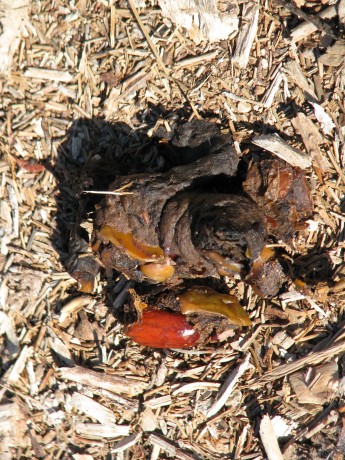
Sorry. Yes, it is coyote scat. Notice the seeds. Tiny seeds show that they were eating figs off of some volunteer fig trees down in the barranca. Larger seeds and skin in the scat shows that they are eating the red Eugenia berries in our yard. There is never much fur in the scat, so these omnivores have to scavenge to stay alive.
On the funny side, one day a few weeks ago I saw some fuzzy green thing in the yard.
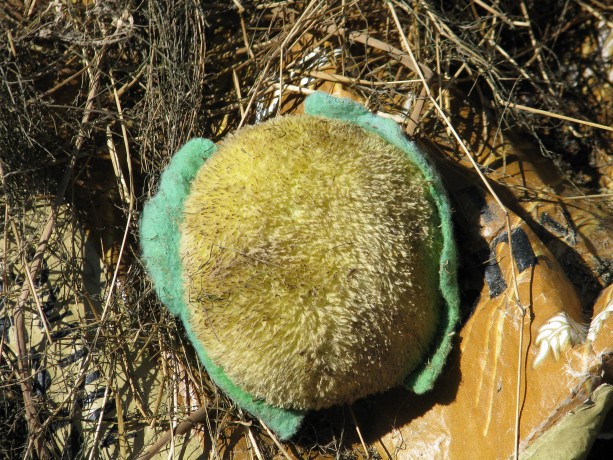
A coyote-delivered squeaky toy. It has since had its squeaker removed, and been slowly shredded by visiting coyotes. It turned out to be what looked like the center of a plush sunflower dog toy. It squeaked. It wasn’t ours. Some young coyote found it in another yard, carried it over the fence and played with it down by our pond. Over the next week it was moved around each night. One morning I found it next to a veggie bed I’d recently planted.
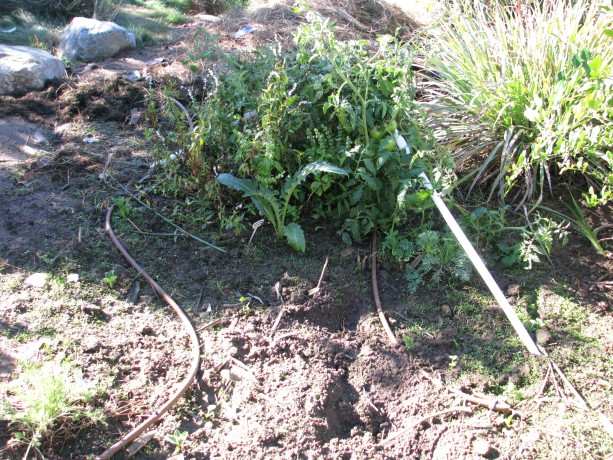
Where is my snake?? Then I realized that the rubber snake I put down in the bed to discourage birds was gone! My daughter and I looked everywhere for the snake, even for pieces of it, but it was gone! Some neighbor is going to have a real bad moment one of these days when walking through their property and they come across my rubber snake.
- Animals, Chickens, Cob, Compost, Composting toilet, Fruit, Gardening adventures, Giving, Grains, Health, Herbs, Houses, Hugelkultur, Humor, Living structures, Natives, Natural cleaners, Permaculture and Edible Forest Gardening Adventures, Ponds, Rain Catching, Recipes, Seeds, Soil, Vegan, Vegetables, Vegetarian, Worms
San Diego Permaculture Convergence, Nov. 9 – 10, 2013
There is a fantastic, information-packed permaculture convergence coming up at the beautiful Sky Mountain Institute in Escondido.
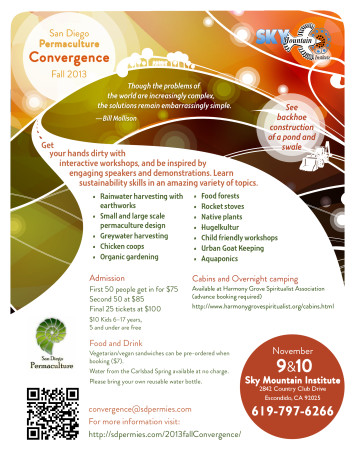 It will be two days packed with great information for a very reasonable price; in fact, scholarships are available. Check out the website at convergence@sdpermies.com. On that Sunday I’ll be teaching a workshop about why its so important to plant native plants, how to plant them in guilds using fishscale swales and mini-hugelkulturs. Come to the convergence and be inspired!
It will be two days packed with great information for a very reasonable price; in fact, scholarships are available. Check out the website at convergence@sdpermies.com. On that Sunday I’ll be teaching a workshop about why its so important to plant native plants, how to plant them in guilds using fishscale swales and mini-hugelkulturs. Come to the convergence and be inspired! -
Release of the Pullets, and No More House Chicken
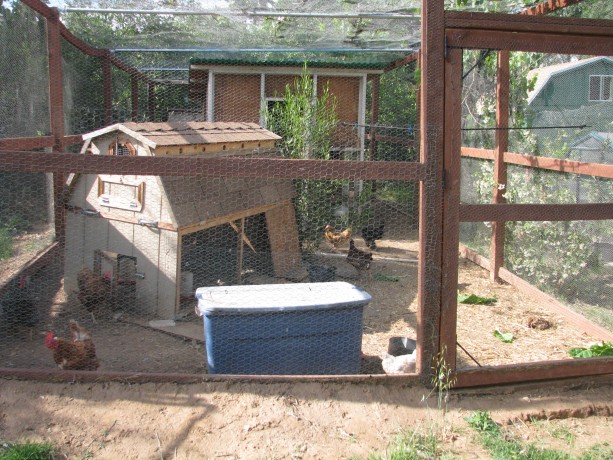
The Fowl Fortress and its many inhabitants. It was time. The little chicks were half-grown and beginning to eat scratch and pelleted chicken food along with their chick starter. They had finally figured out how to go upstairs at nighttime although it took several tries where I had to pick them out of their chick pile and shove them through the upstairs egg window. A couple of times when I’d let the big girls out into the garden, I had let the little girls out into the Fowl Fortress. They had run around stretching their wings and barreling into one another. So it was time for them to join the big girls as one large flock.
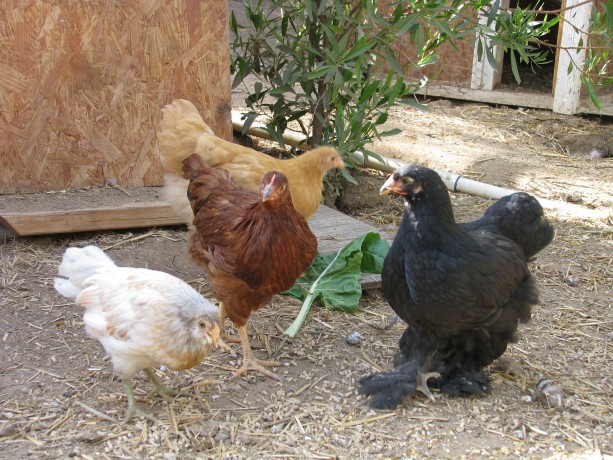
Four of the seven little girls. L-R: Belle, Charlotte, Esther (or Myrtle. They look and act the same), and Mulan (please don’t be a rooster!). And then there was Viola, the house chicken. She’d been a house chicken for over half a year, enjoying her special front yard paradise, coming when called, stealing some dog and cat food, caging herself at night, and crooning away whenever I sneezed or made noise while she slept. I really loved to have my house chicken. However she was alone a lot. She protested her aloneness by shrieking horribly for long periods of time. She could shriek with both exhaled and inhaled breath so that the noise didn’t stop. Even when at the end of my rope I yelled at her to shut up, she shrieked. She was becoming a spoiled and lonesome chicken. Her leg, the reason for her separation from the flock, was doing well again. I thought that if there was ever a good time to reintroduce her it would be at the same time that I let loose the little girls. There would be less hostility against Viola when the hens reinforced their pecking order. It was a very hard decision to make, but I thought it was for the best. I left the cage up in the house, though, just in case.
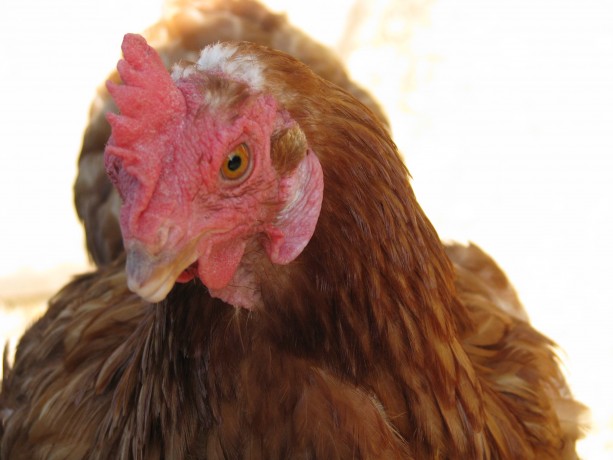
Madge: not just a rescue anymore! Uber hen! Last week I gave Viola a surprise and brought her down to the coop when I let the hens out of their chicken tractor. Viola wasn’t happy about it. Immediately Madge, the one-eyed Rhode Island Red who had been caged with Viola at the feed store when both had been seriously pecked, who had been her only friend for a year with my other girls, decided to punish Viola for her absence and make sure she knew she was at the bottom of the pecking order. She didn’t just give Viola – who is smaller – a peck, she tried to remove feathers. She jumped her and chased her. I had to get between the two of them. Pushing the vicious Blind Pirate Madge away just made her more intense, so I tried picking her up and giving her attention.
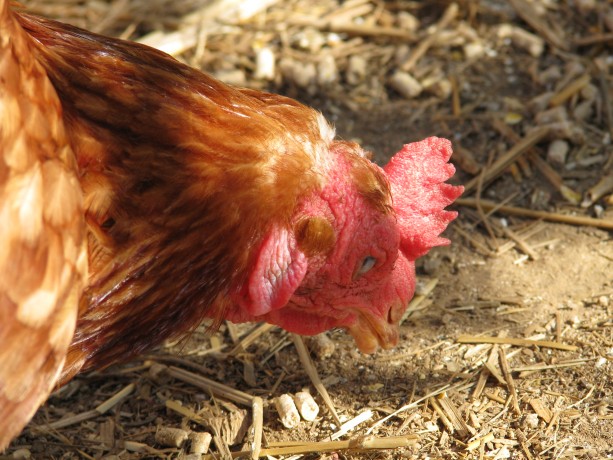
Paritally blind Madge… who’d have thought that she’d give the others the fish-eye? That worked better. Still, Viola had to hide. With Viola between my legs for protection I released the little girls.
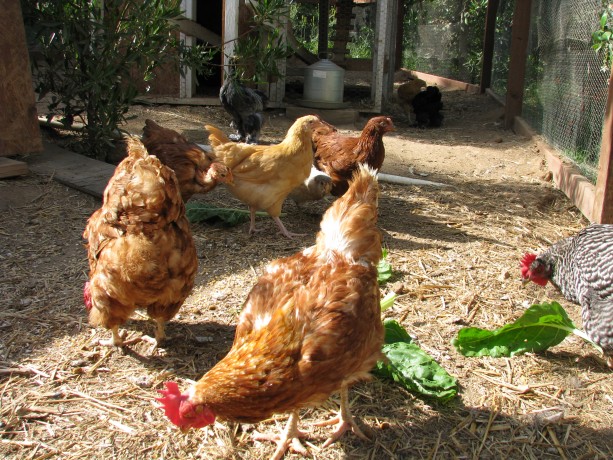
Viola staying close. L-R: Madge’s butt, Malaika, Esther (or Myrtle), behind is Bodacea, crouching is Belle, Charlotte, in the back is Myrtle (or Esther), Mulan, and on the right is Lark. Not pictured: Chickpea and Miss Amelia, the flock leader. The big hens… pretty much ignored them. The little girls were so happy to be free. I kept their food inside their coop and propped the door so that only the smaller birds could get in there, but the big girls managed to shoulder themselves in anyway.
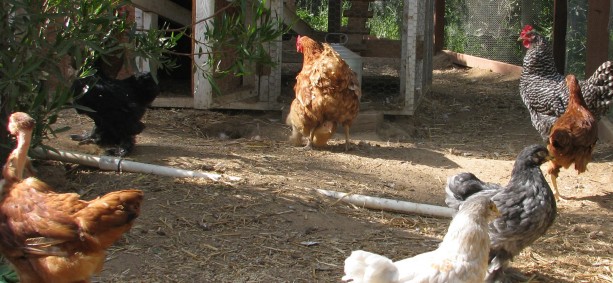
Madge shows her ranking to Myrtle as others look on in alarm. Lark, the Barred Rock who has been barren since she survived egg binding and who has been enjoying her work-free status has developed some kind of uncomfortable swelling. At first I thought she was just fat, but her tummy swelled like a balloon over several weeks. She lost her feathers on her red rump.
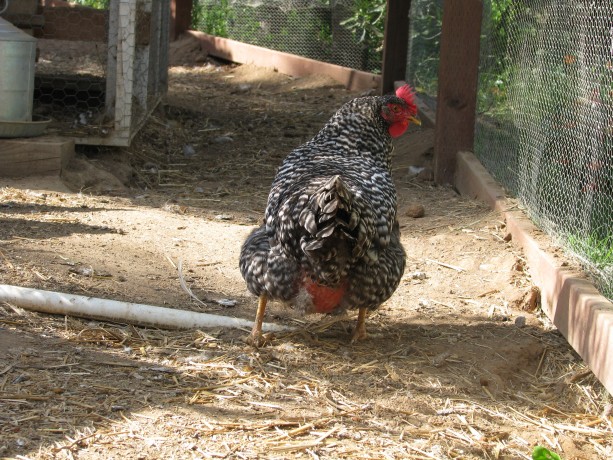
Lark’s uncomfortable ailment. It became awkward for her to walk so I gave her a couple of Epsom salt baths in the kitchen sink, and she became a house guest for a couple of days. She wasn’t as pleasant as Viola, but enjoyed the new experience. I returned her to the coop, and just today the swelling seems much less, thank goodness. The whole illness has not, however, affected her appetite.
Belle, the crossbill Americauna, had such difficulty eating that she is smaller than the rest and seemed to always be famished.
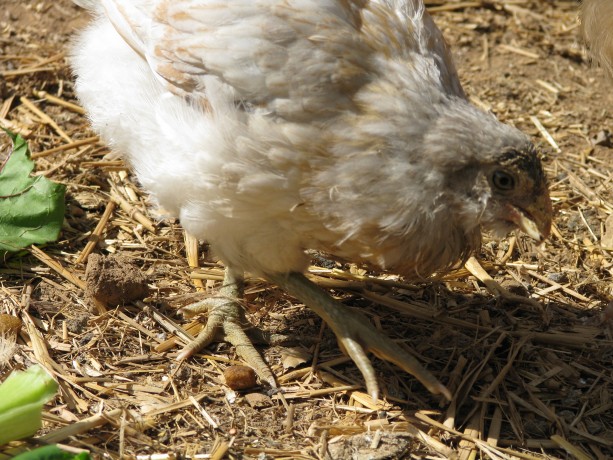
Belle, the Americauna who has the cross-bill trait. Small but sassy, and usually covered with mash. I finally found a small, deep tupperware container that I could wedge between a piece of wood and the side of her coop where it wouldn’t tip over easily, and filled it with chick starter and water mash. Belle was eating heartily for the first time since her bill began to cross and for once she had time to spend goofing around with a full tummy. And a messy face and breast. Since I’d tried trimming her beak, and since I make the magic mash for her now, she has become not only an energetic chicken but a devotee of me. While the other ingrates run away as if I were an axe murderer rather than the vegetarian that I am, Belle flies onto me at any chance. With Viola between my ankles and Belle running up my back I feel very much a part of the flock.

Ah haz a friend! -
Chick’s New Home
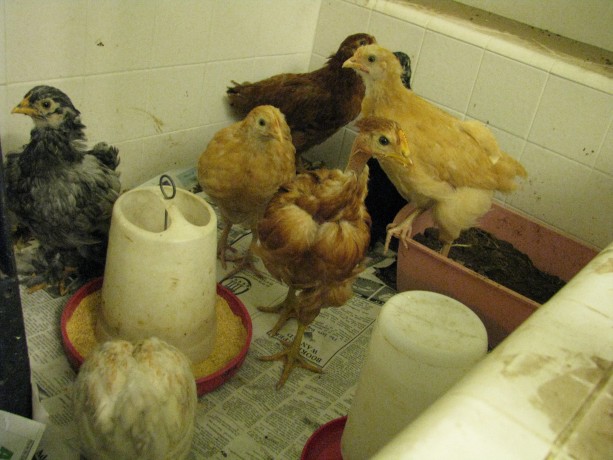
“We’re going where?” I know, I know, another chicken post. This should be the last one for awhile and I’ll get back to plants and chocolate desserts. Today I moved the 6-week-old chicks from out of the bathtub to their new quarters. They are living in a coop within the Fowl Fortress.
The coop had been occupied by Saki, a coturnix quail that ended up being male and thus having to be separate from the other two who were female. Males are extremely aggressive and usually have a harem of at least six. I don’t eat fertile eggs, nor want to hatch more quail so he was separate. He also managed to injure his wing a month ago, then a week ago escape the Fowl Fortress and unfortunately get himself killed. I miss his warbling, frantic call for his ladies. The coop had also apparently been occupied by mice and rats, as I found out when I cleaned out the top nesting portion. The rodents would only use it during the night and disappear like fairies by day, leaving lots of un-fairy-like poo all over the place. I cleaned it out on top while the big girls helped kick out all the old nesting material from the inside.

Getting a little help from my friends (Madge) cleaning out the coop. The girls (and I certainly hope they are!) were so much larger than the last time I carried them outside to the porch that I could only fit three into the banker’s box and had to put another one upside down on top to keep them there for transportation down the hill. I thought I’d put them into the top portion so they’d get familiar with it, then make their way down the ramp to the bottom.
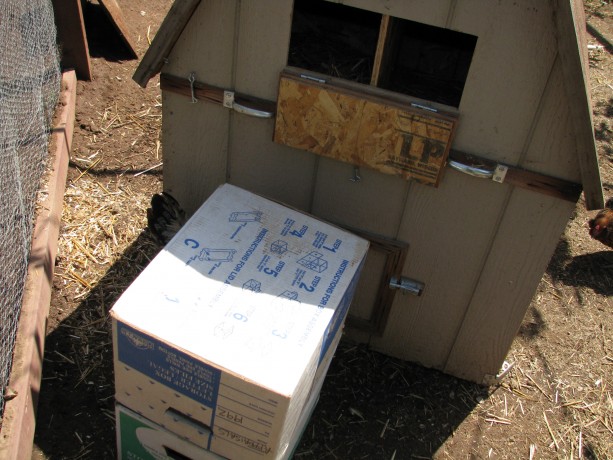
Two banker’s boxes with three huge chicks waiting to be shoved through that egg-collecting door. For over an hour all I heard was rustling, tiny little rushed footsteps and an occasional mini-squawk. I tried to entice them down, but for a long time there were no takers. Finally two came down, and one went up again, then another came down and went up again. About an hour later I looked in and they were all down enjoying the afternoon sun and wondering where the plumbing was (they lived in a bathtub… get it??? 🙂 ).
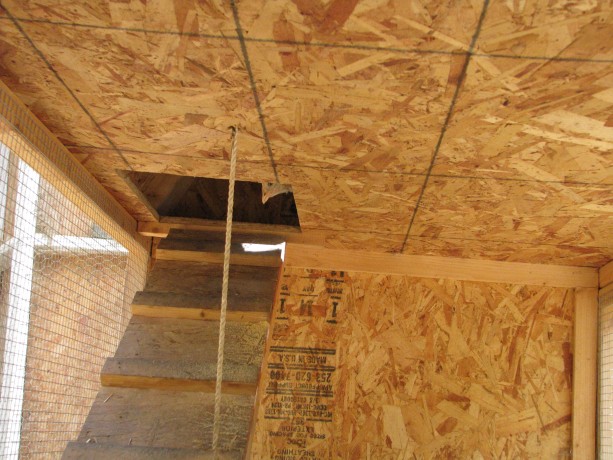
Little peepers peeping. That’s Esther, and she didn’t come down till last. However after sundown when all the big girls went into their coop, the little girls crowded around in the corner looking bewildered. I had to crawl in there, catch them and shove them back up the escape hole into the roosting area.
Kids. Sigh.
Now I need get the offer of cleaning services and clean the bathroom and the entire mostly empty bedroom which is coated with a thin film of chick dust.
But not tonight.

